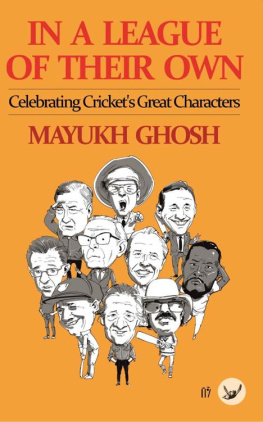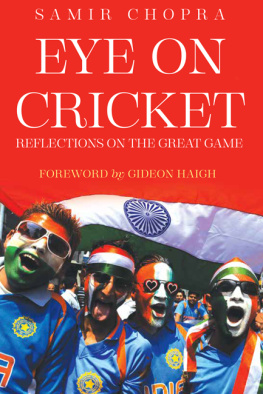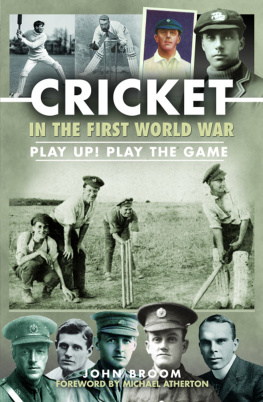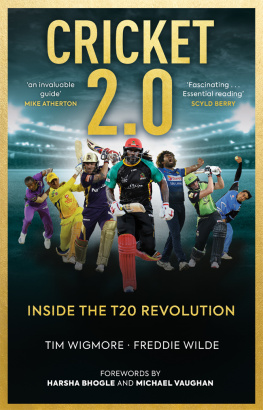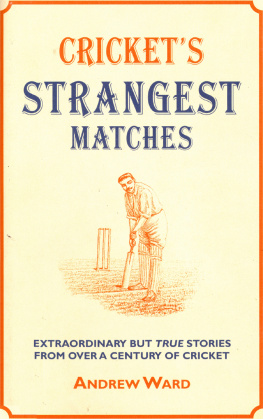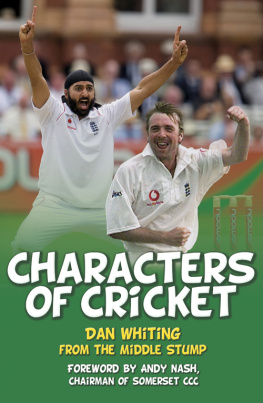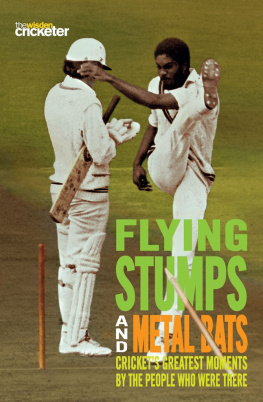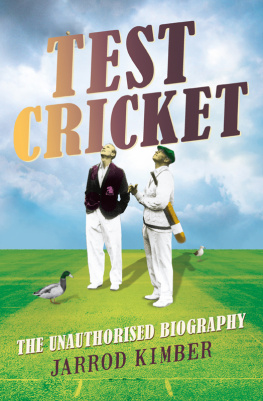IN A LEAGUE OF THEIR OWN
Celebrating Crickets Great Characters
Mayukh Ghosh

IN A LEAGUE OF THEIR OWN
A Collection of Cricketing Anecdotes
by Mayukh Ghosh
ISBN - 978-93-88887-48-9
First Edition - June, 2019
Published by Flying Turtle, an imprint of Sristisukh Prokashan LLP, Bagnan, Howrah 711312
International Edition November 2019
CricketMash, Amstelveen, Netherlands
Cover and Illustration - Sumit Roy
Mayukh Ghosh, 2019 All rights reserved
The book is sold subject to the condition that no part of this book may be used or reproduced in any form, any manner without publishers prior consent.
Preface
A few weeks ago, renowned cricket historian David Frith gently asked me: Are you a well-to-do businessman or a prince by any chance?
I had informed him about some recent acquisitions. I had to reply that I was neither. Nor do I have a princely monthly income. Whats more, my father is no millionaire.
Collecting cricket books and memorabilia while living in India might be tough, but it is still easier than convincing my parents that I must skip school whenever India plays!
That was about 20 years ago. All I had read on the game then was Sunil Gavaskars Idols and Sunny Days.
However, slowly but surely, in my book, it became the history and the literature of cricket that transformed it into the greatest of all games.
I must thank famous cricket writer Arunabha Sengupta for playing a part in the writing of this book. He was generous enough to send me a few good books, which helped ignite the flame!
These days, I routinely skip watching meaningless ODIs to read on the game. Then one sunny morning (dont ask me why), I just decided to share some of the stories with other cricket enthusiasts I know.
So, by all means, an accidental writer.
Or, perhaps, a narrator.
There are some interesting stories about some interesting cricket personalities. I have enjoyed writing them. I hope you enjoy reading them.
Mayukh Ghosh
January 2019
Giants of the Game
1 Ray Lindwall
According to Wisden , it was 'one of the dreariest batting displays'.
It was orchestrated by one of the finest fast bowlers ever.
Place: England
Year: 1956
Keith Miller, after taking a break on Godfrey Evans' Thames houseboat, took half the team to London for a party and failed to return next morning to play in Australia's match against Hampshire. Miller was supposed to lead the team.
Ray Lindwall found himself temporarily taking Miller's place, but he had only four others to begin the game!
Lindwall was never short of ideas.
This time, he told the quartet: Don't worry. I've got a few ideas.
When Hampshire's captain Desmond Eagar asked about toss, Lindwall said, We can't toss, Desmond. The pitch is too wet.
He knew the pitch was dry but precious minutes were wasted as the umpires inspected.
The toss eventually happened. Lindwall knew he had to win it.
And that's easy, he said.
Eagar flipped, Lindwall grunted, then stooped over the coin.
Yep, tails it is. We'll bat.
He returned to Mackay and Rutherford: You guys can forget about runs today. Just don't get out.
Miller finally arrived half an hour before lunch. Rutherford and Mackay were still there, playing forward-defensives against half-volleys.
Lindwall is widely regarded as one of the finest fast bowlers in the history of cricket. In 1956, Australia and England played in the Ashes series. It is famous for Jim Lakers 19-90 in the Manchester Test.
2 SAEED Anwar
A few months ago, Patrick Ferriday (who owns Von Krumm publishing and who has written some good books on cricket) was asked to write on a great day of cricket played in the subcontinent, for the new Wisden Cricket Monthly magazine.
He decided to write on a Saeed Anwar innings in Kolkata.
He asked me if I was there watching the match. He wanted to understand how Eden Gardens 'worked' in those days and what an Indian thinks about Anwar.
By 1999, I had kind of figured out that this man had scored about half a million runs against Indiamore than fifty per cent of them being scored in Sharjah.
Saeed Anwar, on good days, was majestic.
He somewhat struggled against the Australians and South Africans but, in ODIs in Asia, no one ever batted like him.
What if his father didn't return from Tehran just before the hostage crisis?
What if he, like one Mohammad Azharuddin, was not sent to stay with his grandparents?
What if he had not taken a last moment decision to not go to the U.S. to study computer engineering?
And what if he failed that Wellington Test in 1994?
Well, India would have won a few more matches.
And a gifted stroke-player would not have defeated typhoid and/or malaria so quickly to recover in the nick of time for the 1996 World Cup.
And, perhaps, Patrick Ferriday would have taken more time to find the 'right subject'
Saeed Anwar was a leading batsman in the 1990s. He was often at his best in Sharjah and against India.
3 tom wills
Just weeks before the English team arrived to play in Australia, the father of the best Australian cricketer quietly took his son away to a remote location so that he could not take part in the matches.
If he had not done so, the history of cricket could have been slightly different.
Tom Wills was educated at Rugby School in England. His father thought that Tom would get the best education there and hence, at the age of 14, Tom set out for a six-month-long journey by sea. He did well at Rugby.
When he returned to Australia in the mid-1850s, he was a changed man. He walked out to the newly opened MCG in his I-Zingari uniform. He batted like no one could. He bowled so fast that batsmen complained that they were not able to see the ball after it left Tom's hand.
He single-handedly developed Australian cricket.
In 1861, his father thought that was enough of cricket for Tom. He had sent him to Rugby so that Tom could become a lawyer. He, along with Tom, left Victoria to settle in central Queensland.
Weeks later, when Tom was in Victoria for some work, 19 white people were attacked and killed by the Aborigines in central Queensland. One of them was Tom's father. The white men took revenge by killing hundreds of Aborigines.
Tom went back to a blood-stained house and slowly developed post-traumatic stress disorder.
Alcohol came to his rescue.
A year or so later, Tom went back to Victoria to play for the team in a match against New South Wales. As the NSW team were on the brink of defeat, their supporters started throwing stones at Victoria's cricketers. One of them hit Tom. He thought that he had seen enough of the 'cricket played by so-called educated white gentlemen'.
He went back to Queensland and formed a team with 10 aborigines, some of whom had killed his father.
On Boxing Day in 1866, he marched his team to the MCG to play against the local club. Tom Willis, the white captain and 10 aborigines.
He wanted to visit England in 1867 but financial difficulties were too big an obstacle to overcome.
The tour did happen in 1868 but by then Tom had been usurped by Charles Lawrence.
Tom played cricket for a few years, but the alcoholism took a toll on him.
In April 1880, he decided to not touch alcohol anymore, but that proved to be fatal. He quickly developed delirium tremens.
On 1 May, he was admitted to a hospital in Melbourne but they couldn't keep him there for more than a few hours.
The very next day, he took his life by stabbing himself with a pair of scissors.
Next page
